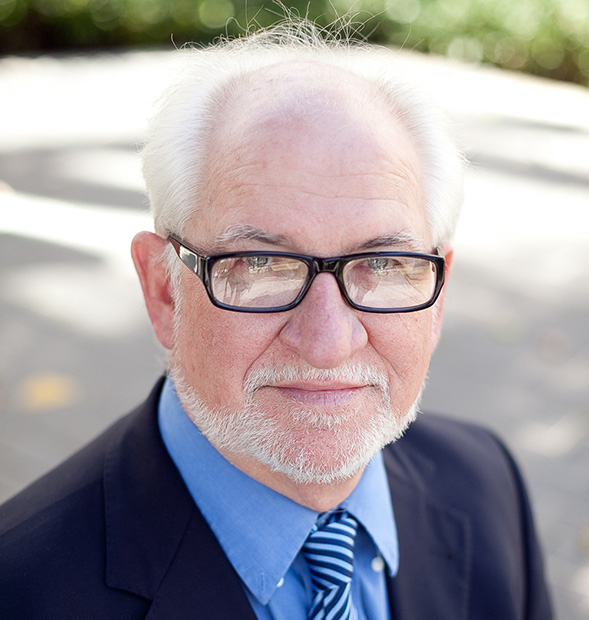Casting a Long Shadow in Public Health
John Elder will receive the Teaching Excellence Award for decades spent serving San Diegos communities.

Consider nearly any aspect of public health in the San Diego region and you’ll find the fingerprints of San Diego State University. The president and CEO of North County Health Services, Irma Cota, earned her master of public health (MPH) from SDSU. So did City of San Diego Commissioner April Riel. Hundreds of public health professionals working in clinics and health organizations throughout the county cut their teeth at SDSU—all under the tutelage of psychologist and behavioral scientist John Elder.“Dr. Elder has provided invaluable support in my development as a scientist. He not only facilitated my involvement in large scale research projects, but also helped me explore my research interests.”
The distinguished professor will be honored with the University Senate’s annual Teaching Excellence Award and give a presentation on the future of public health at a campus ceremony from 2-4 p.m. on Friday, April 21, at Scripps Cottage. The award recognizes the exemplary contributions SDSU teacher-scholars have made to the education of students.
Few educators cast a longer shadow than Elder, who joined SDSU after a non-tenure-track stint as a research professor at Brown University in Providence, Rhode Island, studying public health strategies. With he and his wife, Connie, expecting a child, he sought a more stable job and found an opening at SDSU in the then-new Graduate School of Public Health (GSPH).
“I got my trumpet out and played ‘California, Here I Come,’” he recalled.
Elder arrived in 1984 and shortly after took over the Institute for Behavioral and Community Health (IBACH) as director. He recognized that San Diego’s Latino community was being overlooked in national conversations on public health, so he endeavored to learn more about the people in his new city. He learned Spanish from auditing SDSU classes and reading newspapers in Tijuana. And, critically, he won a grant from the Kaiser Family Foundation.
“Instead of saying, ‘These are the things the community needs,’ they said, ‘Go and find out the needs of the community,’” Elder said.
So he did. With the help of one of his first graduate students, Gregory Talavera—a medical doctor and now a well-respected public health researcher at SDSU in his own right—Elder spent a year meeting with community members, assessing their nutritional needs, school lunch programs and cooking habits. The two also identified the cultural barriers to implementing health programs and opportunities to integrate culture into interventions.
Armed with this knowledge, Elder applied for and was awarded funding from the National Institutes of Health (NIH), which helped him grow the university’s public health program. NIH has consistently supported his work ever since, making him one of the university’s most highly funded researchers.
When Elder arrived at SDSU, nearly every public health graduate student was Caucasian—a poor reflection of the city’s ethnic mélange. Hoping to diversify the students in the program, he placed a special emphasis on recruiting students who were bilingual, had multicultural experiences and deep knowledge of the local community. It paid off. Within a few years, Latino students were well-represented in the GSPH.
“When you have people who look like you, who speak your language, who have names that sound like yours, it’s much less intimidating to enter and succeed in a graduate program,” Elder says.
Nowadays, he teaches a graduate-level health communication course. After 33 years at SDSU, he’s still looking for ways to keep the curriculum fresh and relevant. If you visit his class today, you’ll likely find students analyzing and developing their own social media–based campaigns. The majority of the course materials are found on a Tumblr page.
If history is any guide, a few of these students might return to teach a new generation of the university’s students. Four SDSU professors—Talavera, Guadalupe X. “Suchi” Ayala, Susan Woodruff and Noe Crespo—all took classes taught by Elder. A fifth, Elva Arredondo, worked with Elder as a postdoctoral scholar.
“Dr. Elder has provided invaluable support in my development as a scientist,” says Arredondo, who studies health disparities in the GSPH. “He not only facilitated my involvement in large scale research projects, but also helped me explore my research interests.”
His legacy as a teacher, researcher and mentor resounds throughout SDSU’s and San Diego’s communities, adds Ayala, associate dean for research in the College of Health and Human Services and the current director of IBACH.
“One of the most important attributes that Dr. Elder brings as a teacher and mentor is his ability to see every student’s individual potential and to raise their sights for what might be possible for themselves, their families and their communities,” Ayala says. “He is among the most important reasons why many of us are here and remain at SDSU.”



